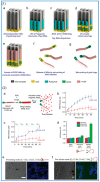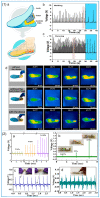Processes of Electrospun Polyvinylidene Fluoride-Based Nanofibers, Their Piezoelectric Properties, and Several Fantastic Applications
- PMID: 36297889
- PMCID: PMC9608489
- DOI: 10.3390/polym14204311
Processes of Electrospun Polyvinylidene Fluoride-Based Nanofibers, Their Piezoelectric Properties, and Several Fantastic Applications
Abstract
Since the third scientific and technological revolution, electronic information technology has developed rapidly, and piezoelectric materials that can convert mechanical energy into electrical energy have become a research hotspot. Among them, piezoelectric polymers are widely used in various fields such as water treatment, biomedicine, and flexible sensors due to their good flexibility and weak toxicity. However, compared with ceramic piezoelectric materials, the piezoelectric properties of polymers are poor, so it is very important to improve the piezoelectric properties of polymers. Electrospinning technology can improve the piezoelectric properties of piezoelectric polymers by adjusting electrospinning parameters to control the piezoelectrically active phase transition of polymers. In addition, the prepared nanofibrous membrane is also a good substrate for supporting piezoelectric functional particles, which can also effectively improve the piezoelectric properties of polymers by doping particles. This paper reviews the piezoelectric properties of various electrospun piezoelectric polymer membranes, especially polyvinylidene fluoride (PVDF)-based electrospun nanofibrous membranes (NFs). Additionally, this paper introduces the various methods for increasing piezoelectric properties from the perspective of structure and species. Finally, the applications of NFs in the fields of biology, energy, and photocatalysis are discussed, and the future research directions and development are prospected.
Keywords: biomedicines; electrospinning; energy; photocatalysis; piezoelectric properties; polyvinylidene fluoride.
Conflict of interest statement
The authors declare no conflict of interest.
Figures
















References
-
- Mason W.P. Piezoelectricity, its history and applications. J. Acoust. Soc. Am. 1981;70:1561–1566. doi: 10.1121/1.387221. - DOI
-
- Curie P., Curie J. Développement par compression de l’électricité polaire dans les cristaux hémièdres à faces inclinées. Bull. Minéral. 1880;3:90–93. doi: 10.3406/bulmi.1880.1564. - DOI
-
- Sirohi J., Chopra I. Fundamental understanding of piezoelectric strain sensors. J. Intell. Mater. Syst. Struct. 2000;11:246–257. doi: 10.1106/8BFB-GC8P-XQ47-YCQ0. - DOI
-
- Bowen C.R., Kim H.A., Weaver P.M., Dunn S. Piezoelectric and ferroelectric materials and structures for energy harvesting applications. Energy Environ. Sci. 2014;7:25–44. doi: 10.1039/C3EE42454E. - DOI
-
- Chang J., Dommer M., Chang C., Lin L. Piezoelectric nanofibers for energy scavenging applications. Nano Energy. 2012;1:356–371. doi: 10.1016/j.nanoen.2012.02.003. - DOI
Publication types
Grants and funding
LinkOut - more resources
Full Text Sources

